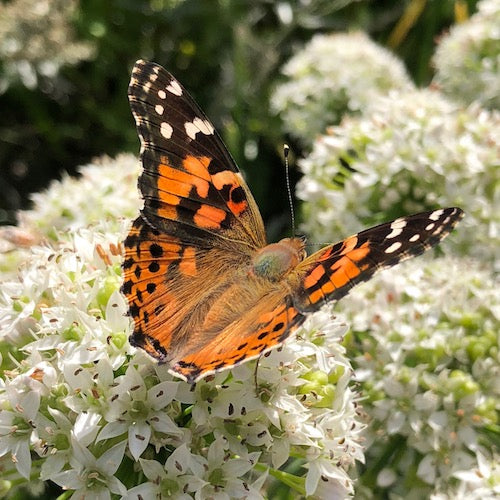Gardeners may be feeling ambivalent about the soaring temperatures, caught between the drawn-out wait for summer and the reality that 30+ degrees plus humidity is not the most comfortable. However, one treat these days is the opportunity to observe all of the very active butterflies, which thrive as temperatures get into the high 20's and above.
Of course, many gardeners champion the idea of planting for butterflies, but it seems like a good time to review three key strategies to encourage healthy butterfly populations in our yards.
Consider the needs of both caterpillar and adult life stages of butterflies
A famous example that describes this point is the Monarch: the adults feed on nectar from many types of flowers but Monarchs will only lay their eggs on milkweed as Monarch caterpillars feed exclusively on milkweed (an adaptive strategy as the milkweed makes the caterpillars poisonous to predators). The term "host plant" references this phenomenon, and many butterflies have very specific plants they lay eggs on, while the adults will feed on nectar from varied blooms. As gardeners, we can improve our habitats by not only including diverse flowers that are generally good food sources for adult butterflies but also start to get to know the specific host plants for local butterflies... it is exciting to see the diversity of Lepidoptera that occur in Manitoba!
At Sage Garden, we make a big effort to add specific butterfly host information to our perennial plant info signs, to help guide you. Another fabulous resource is the book Manitoba Butterflies by Simone Allard (we need to get these back in stock!), and of course, we can't say enough good things about Kelly and her team at Prairie Originals.

Make a "puddling pad" for butterflies
This couldn't be easier and adds charm to your outdoor displays. A puddling pad provides a safe water source for butterflies, but more importantly, it offers an inviting location for butterflies to display their natural behaviour of congregating around the edge of shallow puddles. Butterflies do this to access minerals that are concentrated as water evaporates from shallow wet spots; it is thought that male butterflies puddle more than females as they require extra minerals specifically for male butterfly reproductive processes. Puddling behaviour occurs most often during the peak heat of the day.
To create your own puddling pad, simply choose a shallow container such as a clay plant saucer, add attractive pebbles and a little water. This may require refilling daily. Some sources recommend adding a little salt, mud or other natural materials that will increase the mineral content of the evaporite.

Go really pesticide-free
Outdoor gardens are graced with both good bugs and bad bugs, and in general, the healthiest balance occurs when humans intervene as little as possible. Anytime we apply a pesticide, even those considered gentle or organic, it may impact both the beneficial and pesky critters that occur. So, a less is more approach is the current best practice. When it comes to butterflies, we need to keep in mind that most pesticides can harm both adults as well as the caterpillar and egg stages of this natural wonder. Of course, growing plants organically and sourcing plants free from systemic pesticides is our philosophy.








